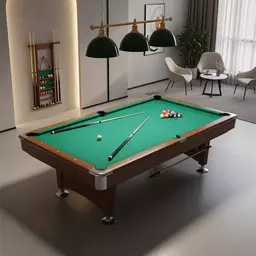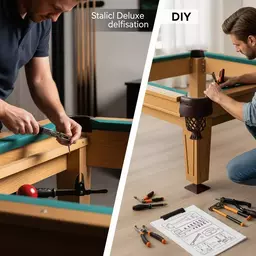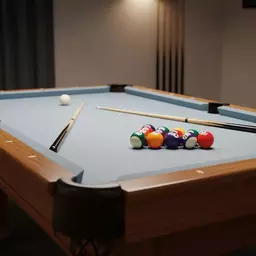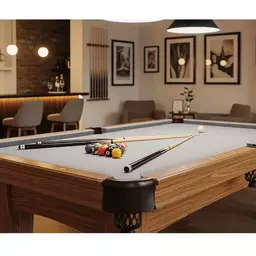Material Comparison: Slate vs. MDF
Slate
- Durability: High
- Playing Surface: Smooth & Level
- Recommendation: Serious Players
MDF
- Durability: Moderate
- Playing Surface: Lighter, Easier to Move
- Recommendation: Casual Players, Budget-friendly
What if the perfect pool table for your space is just a few insights away? The world of pool tables is rich with options, and understanding their intricacies can transform your gaming experience. Let’s dive into the key takeaways that will empower you to make an informed choice!
This visual compares key characteristics of different pool table materials, playing surfaces, and types, highlighting their impact on performance and suitability.
As a pool table enthusiast, I know how exciting it is to explore the different types of tables available! Understanding the various categories can help you find the perfect fit for your space and playing style. The global pool table market is experiencing significant growth, with projections indicating a robust future, as highlighted by reports from Straits Research and Market Research Future.
There are several main types of pool tables, each designed for specific playing experiences. The most common types include:
Choosing the right type depends on your skill level and the space you have available. For instance, if you have a large game room, a full-size table could be perfect for hosting friends and family!
When diving into the world of pool tables, it’s essential to know the differences between American and British styles. Here are some key distinctions:
Understanding these differences can greatly enhance your game experience! Whether you prefer the fast-paced action of American pool or the strategic play of British pool, knowing your table type is key.
Beyond standard pool tables, there are also specialty options that cater to various games. Let’s look at a few:
Specialty tables not only offer different gameplay experiences but can also serve as stunning centerpieces in your game room. They invite conversation and enhance the overall atmosphere of fun!
When considering a pool table, the material of the playing surface plays a crucial role in your gaming experience. The two primary materials are slate and MDF.
Ultimately, selecting the right material depends on your budget and how often you plan to use the table. If you're a casual player, MDF might be just fine, but for serious gameplay, slate is the way to go!
Italian slate is often considered the gold standard for pool tables due to its quality and precision. Here’s what sets it apart:
Investing in an Italian slate table can significantly enhance your playing experience, making it a worthwhile consideration for serious enthusiasts!
Felt can affect gameplay, so it’s important to choose the right type for your pool table. Here are the two main types:
When selecting felt, consider how you play and what you enjoy. A faster felt may be preferable for competitive play, while nap felt could enhance a more casual atmosphere.
Lastly, it’s crucial to understand pool table dimensions to ensure you choose the right size for your game area. Here are some common dimensions:
Measuring your space before making a decision is essential. Aim for at least five feet of clearance around the table for optimal play! This ensures that you and your guests can cue comfortably while enjoying your games. For more detailed insights into the market dynamics and factors driving demand for pool tables, a comprehensive analysis is available from Verified Market Research.
As you consider your next pool table, what features do you prioritize the most? Is it the material, size, or perhaps the table's design? Share your thoughts below:
A1: Slate surfaces are highly durable and provide a smooth, level playing field, making them ideal for serious players. MDF (Medium Density Fiberboard) is a more affordable and lighter alternative, suitable for casual players and those on a budget, though it may not offer the same level of playability.
A2: Italian slate, sourced from the Italian Alps, is known for its natural smoothness, durability, and typically thicker construction. It is precision-cut to ensure a perfectly level playing surface, significantly enhancing the playing experience for enthusiasts.
A3: American pool tables are generally larger (7-9 feet) with larger balls (2.25 inches) and emphasize ball pocketing. British pool tables are smaller (7-8 feet) with smaller balls (2 inches) and focus more on strategy and skill due to fewer pockets.
A4: Common dimensions include 7-foot tables for smaller spaces or casual play, 8-foot tables as a popular home choice, and 9-foot tables for professional or competitive settings. It's recommended to have at least five feet of clearance around the table for comfortable cueing and optimal play.
A5: Billiards (or carom) tables have no pockets and focus on skill and precision in games like carom billiards. Snooker tables are larger than standard pool tables, feature smaller pockets, and are used for the detailed and strategic game of snooker.
As we wrap up our deep dive into the world of pool tables, it's essential to recap the fundamental aspects we've covered. We explored the various types of pool tables, from full-size models to portable options, ensuring you understand what fits your needs. We also discussed the importance of materials, highlighting the durability of slate against the affordability of MDF, which can significantly affect your gameplay experience.
In addition, we reviewed key buying considerations, such as frame quality, surface types, and the significance of choosing the right size for your space. Whether you're eyeing a sleek modern design or a classic traditional table, all these factors play a crucial role in your decision-making process.
With these insights in hand, you're well on your way to making an informed decision about your next pool table purchase!
Now that you’ve gained a solid understanding of pool tables, it's time to take the next steps! I encourage you to assess your unique needs and preferences. Do you have limited space? Are you looking for a table that complements your home decor? Jot down your thoughts and priorities to help guide your selection process.
For a more structured approach, consider downloading our buyer’s checklist, which outlines everything you need to consider before finalizing your purchase. This handy tool can ensure you don't miss any crucial factors!
Finally, I invite you to visit local retailers or reputable online shops to explore your options. Seeing tables in person can make a world of difference, and it allows you to get a feel for the quality and craftsmanship. Remember, the perfect pool table is out there waiting for you to bring it home!
Here is a quick recap of the important points discussed in the article:

 As you consider adding a pool table to your space, think about how its size can significantly influe
As you consider adding a pool table to your space, think about how its size can significantly influe
 Are you ready to elevate your game room experience? Understanding the assembly process of your new p
Are you ready to elevate your game room experience? Understanding the assembly process of your new p
 As a pool table owner in Melbourne, you want to ensure your investment lasts, and that means underst
As a pool table owner in Melbourne, you want to ensure your investment lasts, and that means underst
 Have you ever considered how your purchasing choices impact your community? When it comes to buying
Have you ever considered how your purchasing choices impact your community? When it comes to buying